
Libraries Directory Home • Online Guide • A to Z
 |
The Libraries Directory 50th Edition Libraries Directory Home • Online Guide • A to Z |
Search Types • Setting Parameters • Query Searches • Text Searches • Viewing the Results
The Libraries Directory application has an advanced search option which allows you to set up complex searches with multiple parameters and criteria, and to save them so that you can run them again later without having to recreate them from scratch. To perform a search, select Advanced Search from the Search menu or the Short Cut menu.
For quick searches in a single index, see Simple Index Searching.
The Advanced Search dialog allows you to build your search in three stages. In the first stage, you can select the type of search you want to perform:
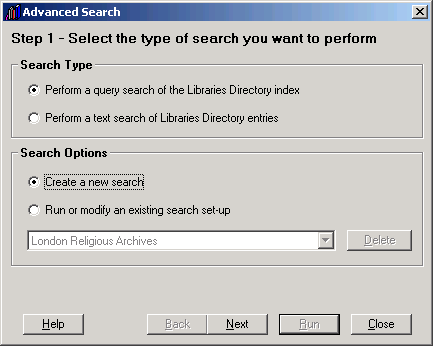
You can run one of two different types of search:
Query Search - searches the indexes for entries matching your criteria.
Text Search - searches the entries themselves for specific text values.
Query searches are generally faster, but are limited to terms that have been indexed. Text searches tend to be slower, but can pick up terms that may not appear in the indexes.
You can also choose to perform a new search, or to run or edit a search that you have previously saved. Previously saved searches can also be deleted at this stage.
Select the desired search type, and the existing search (if any) that you want to run. Then click on the Next button to proceed to the next step.
Next, set up the general parameters for your search. These will determine the range of entries to be included in the search:
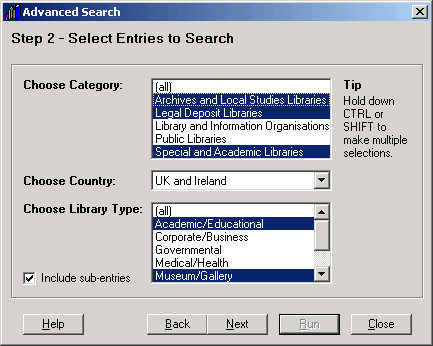
| 1. |
Select the categories to search in (choose any one category, all categories, or any combination). |
|
|---|---|---|
| 2. |
Select whether or not to include branches and sub-entries in your search. Tick the check-box to ensure that branches and other sub-entries are included in the search results. Untick the check-box to exclude them and to concentrate your search on main entries. |
|
| 3. |
Select the country to search in (choose United Kingdom, Ireland or both). |
|
| 4. | Select the types of library or institution to search for (choose any one type, all types or any combination). |
To make multiple selections in the Category and Type lists, hold down the Control key or the Shift key while you make your selection.
To proceed to the third and final step, click on the Next button.

If you have chosen to run a query search, the final stage allows you to specify a combination of search terms or criteria spanning multiple indexes:
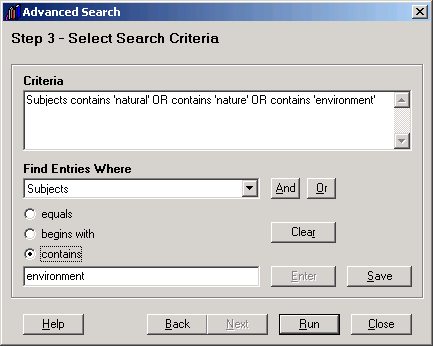
| 1. |
First, choose an option from the Find Entries Where drop-down list. You can search for all the entries that you have specified so far, by selecting the '(all entries)' option, or you can narrow down your search further by specifying a combination of terms to search for in one or more of the indexes. For example, if you just want to run a search for all private or academic archives, then select the Archives and Local History Libraries category, and the Academic/Educational and Private types during the previous step. Then select the '(all entries)' option from the Find Entries Where drop-down list, and run your search. However, if you want to find a more specific range of entries, such as all private or academic archives in Edinburgh or Glasgow, or all private or academic archives which hold both political and literary papers, then you will need to create one or more search criteria first. |
|
|---|---|---|
| 2. |
To create your criteria, select an index from the drop-down list, and then choose how you want your search term to be compared with the index values. The "is equal to" option looks for an exact match, "begins with" looks for index values starting with the term, and "contains" looks for any occurence of the search term within the index value. |
|
| 3. |
Then type your search term into the text box (you do not have to reproduce the exact case, since the search is not case-sensitive). You also use pattern-matching wildcard characters in your search term: use ? (question mark) to represent any single character, and use * (asterisk) to represent any combination of characters. |
|
| 4. |
Then either press the Enter key or click on the Enter button to add the criterion to your search. Your criteria are displayed at the top of the Advanced Search dialog, so that you can keep track of them. If you make a mistake or change your mind, you can delete your current criteria with the Clear button, and start again. |
|
| 5. | To add additional search criteria, you must first decide whether you wish to perform an "And" search (so that only entries that match both criteria are found) or an "Or" search (so that entries that match either criteria will be found). Click on the And button or the Or button accordingly, and enter the next criterion as before. You can build up a list of up to eight criteria in this way. |
When you are happy with the search that you have defined, you can run it by clicking on the Run button. If you wish to save the details of the search, so that you can run it again in future, you should click on the Save button before you run the search, and enter a unique and easily identifiable name in the dialog box that appears.
You can click on the Back button at any stage to return to the previous step, or click the Close button to exit the dialog without searching.

If you have chosen to run a text search, the final stage allows you to specify your search terms and how they are to be compared with the text of the Directory entries:
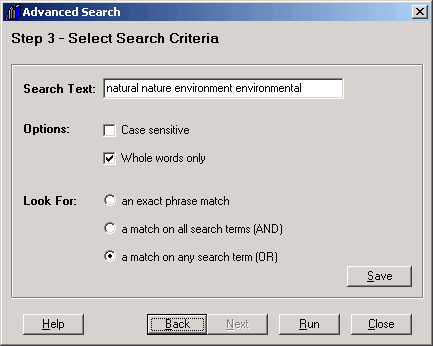
| 1. |
First, enter your search terms. You can enter a single term or a number of terms separated by spaces, or you can enter a particular phrase. Please note that the text search does not support the use of wildcards. |
|
|---|---|---|
| 2. |
Specify whether or not the search is to be case-sensitive, and whether your search terms must match whole words only. |
|
| 3. | You can also specify whether you want an exact phrase match (if you are searching for a particular phrase), a match on all search terms (equivalent to an AND comparison), or a match on any search term (equivalent to an OR comparision). |
When you are happy with the search that you have defined, you can run it by clicking on the Run button. If you wish to save the details of the search, so that you can run it again in future, you should click on the Save button before you run the search, and enter a unique and easily identifiable name in the dialog box that appears.
You can click on the Back button at any stage to return to the previous step, or click the Close button to exit the dialog without searching.

Depending on the complexity of the search that you have defined, an advanced search may take several seconds to be run. A Search Results page is then displayed in the main window:
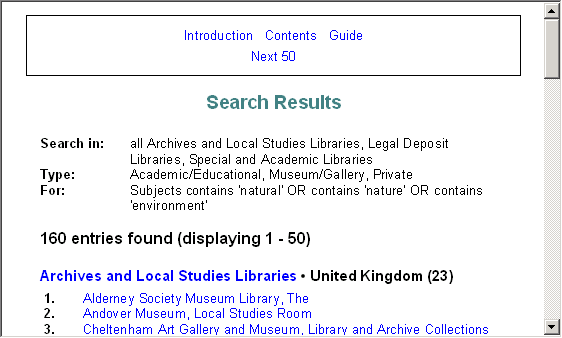
Search results are listed by category and country, with individual entries arranged alphabetically by name. Each page of results lists up to 50 entries. Links to the Next and Previous pages of results are included at the top and bottom of each page.
There is no maximum number of search results that can be displayed. However, if your search returns more than 1,000 results, a warning dialog will appear, allowing you to cancel your search and try again using narrower search parameters.
To go to an entry, simply click on its name.
See Also

About the CD-ROM
How the Directory is Indexed
How the Entries are Organised
Finding Your Way About
Simple Index Searches
Using the Menus
Setting Your Own Options
Other Facilities
James Clarke and Co Ltd
PO Box 60, Cambridge, CB1 2NT, England
Tel: +44 (0) 1223 350865 Fax: +44 (0) 1223 366951
email: publishing@jamesclarke.co.uk